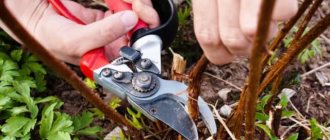Features of caring for boxwood in the fall and preparing for winter
Although boxwood cannot be called a whimsical crop in the summer, the autumn months involve a fairly large amount of work associated with this plant. After all, it is quality care in the fall that will determine whether boxwood can quickly recover from winter with the arrival of warmth. When growing this plant on your site, it is worth remembering several important points:
- Boxwood leaves contain toxic compounds that can cause chemical burns. Therefore, caring for the plant must be done with rubber gloves, a robe and a face mask, which must be washed along with garden tools after each use.
- All care procedures, including pruning, watering and mulching, should be carried out before the arrival of frosty days.
- Since boxwood is very sensitive to the sun and begins to actively sprout at the slightest warming, it is worth planting it in the shade of large plants or near buildings on the north-eastern and north-western side.
- In spring, the cover from the bush is not immediately removed. First, the trunk circle is opened slightly at the very base of the plant, then after 7-10 days the protective layer is removed from the top of the boxwood. Snow and leaves are removed from the tree trunk circle so that the soil warms up faster.
Winter pruning
Formative pruning of boxwood should be carried out in mid-summer, when the first stop in growth of the evergreen shrub occurs. At this time, the sap flow inside the shoots has not yet stopped, and the boxwood will still enter the active growth stage. Pre-winter pruning is carried out at the end of October - beginning of November, when two growth periods have already passed, but severe frosts have not yet occurred. At this time, young shoots are pruned in order to start the growth process of young shoots after the onset of spring. With this pruning, up to 2 cm of branches are removed.
The basal shoots are pruned to the third young bud if it is necessary to form a branch. Pruning is carried out to the second young bud if it is planned to leave the shoot without branching.
Caring for boxwood in autumn
Caring for the plant in the fall is not too burdensome, but it requires sufficient attention and time. As in the summer, it comes down to watering, fertilizing, mulching and pruning. However, each of these procedures has its own nuances, following which will make it easier for the boxwood to winter and help maintain the health of the bush.
Watering and fertilizing
Deep watering will help energize the plant for the coming winter months. It is necessary for boxwood to nourish its cells with the liquid it will need in a snowless winter with drying frosts and strong winds. In such conditions, the bush quickly evaporates water, and its initial lack will lead to freezing of the boxwood and its death. Therefore, 1 - 2 weeks before the onset of frost, you should generously water the plant with settled water at room temperature. For watering, it is better to choose a dry, sunny day, and carry out the procedure itself in the morning or 3-4 hours before dusk, so as not to provoke the development of fungal diseases in the boxwood.
As for fertilizing, potassium and phosphorus fertilizers will also perfectly saturate the plant before the winter months and accelerate the growth of green mass in the spring. However, you should feed boxwood for the last time for the season no later than mid-September, otherwise, instead of going into a dormant state, the crop will sprout new shoots. The best time for final feeding is considered to be the end of August, and in warm regions - the first days of September.
Mulching
When caring for boxwood, one should not underestimate the importance of such a procedure as mulching. Correctly carried out action can, no less than, save the bush from freezing on harsh winter days, as well as from flooding during snow melting, since mulch ensures optimal water and heat exchange in the roots of the plant. As a rule, boxwood is mulched 2 - 3 days after water-recharging watering. Peat, rotted pine needles or crushed pine bark are often used as mulch. The layer of mulching material is made 5-10 cm thick, while at the base of the plant a free space with a diameter of 2-3 cm is left.
Important! It is not recommended to use fallen leaves for mulch. Although the foliage retains heat well, it tends to become warm, which is why parasites and fungal infections begin to multiply in it.
Trimming
An important procedure in caring for boxwood is pruning. In summer, the plant is pruned mainly to maintain the decorative appearance of the bush at intervals of once every 1 - 2 months. Pre-winter pruning, which is carried out at the end of October before frost, has other goals. It is aimed at stimulating the growth of young boxwood shoots during the spring growing season. As a rule, during this procedure, damaged and old branches are completely removed, and the remaining branches are shortened by 1.5 - 2 cm. Moreover, only bushes older than 2 years need pruning. Younger specimens with a less developed root system will be too weakened after the procedure and may not recover after the cold.
Protection from diseases and pests
Since the foliage of the plant contains toxic substances, this makes the crop very resistant to a variety of pests and diseases. However, there are also insects that attack boxwood, despite its protective functions.
For example, the boxwood fly, which feeds on the pulp of leaves, gnawing tunnels in them, is not only voracious, but also resistant to low temperatures. The larvae of this parasite successfully survive the winter and devour the plant with renewed vigor in the spring.
The boxwood felt borer causes just as much damage to boxwood by eating its branches and leaves. In addition, he, like the fly, is not afraid of the cold, so he can suddenly remind himself during the growing season of the plant in the spring, when, it would seem, the plant has gotten rid of this scourge.
Both pests can be controlled by treating the bush with insecticides in late April - May. In the fall, you can also take certain actions to combat them: for example, timely removal of injured branches and leaves and burning them. Whitewashing tall plants will also help against attacks by parasites.
Transfer
Caring for boxwood may include the need to replant the plant, which, like the initial planting, is carried out before winter. For successful development, the location of the bush is changed at intervals of 3 to 4 years until it grows large enough. The optimal time for this is considered to be the period from late July to early November, depending on the growing region. When choosing a day for replanting, it is worth considering that the bush needs at least 1 month for successful rooting, so it is advisable to organize it before cold weather sets in.
The location of the transplant is also of great importance. The quality of the soil is not very important when it comes to boxwood, but on fertile, loose soil the plant will grow stronger much faster. At the same time, they focus on moderately moist soil, and groundwater should not lie too close to the surface, otherwise the roots of the bush will begin to rot.
As a rule, when transplanting boxwood, plant growers are guided by the same algorithm of actions as when planting in open ground:
- 24 hours before the procedure, the plant is generously watered to make it easier to extract the roots with a lump of earth.
- The planting hole is dug 3 times larger than the earthen clod.
- A drainage layer of perlite or other absorbent material 2-3 cm thick is laid at the bottom.
- Then mix perlite from the soil in a 1:1 ratio and pour it over the drainage so that subsequently the upper part of the earth ball with roots is flush with the surface. The empty space around the roots is also filled with the mixture and the soil is lightly compacted.
- Upon completion of the procedure, the boxwood is intensively watered with rain or settled water.
Diseases and pests
The main enemy of boxwood, the boxwood moth, does not live in Siberia or the Urals. However, other pests live in these regions - mainly fungal infections and some insects:
- spider mite;
- gall midge fly;
- mealybug.
Also, boxwood in Siberia and the Urals can suffer from powdery mildew, rust and other fungal diseases. Another dangerous pathology is cancer of the root system. This disease cannot be treated: the affected bush can only be dug up and burned away from the garden.
It is important to understand that treating boxwood in these regions is difficult - in most cases the bushes cannot be restored to health. Therefore, 2 times a season it is recommended to carry out preventive treatment with fungicides and insecticides:
- The first time was in early spring after removing winter shelters.
- The second time at the end of autumn before the formation of shelters for the winter.
For spraying, you can use complex products in an amount of 10 mg of the drug per standard 10 liter bucket of water.
Important! It is quite possible to defeat boxwood diseases in the early stages. Therefore, it is advisable to regularly inspect the bush and have a supply of treatment products.
Characteristic symptoms of mealybug infestation are the presence of a white coating on the leaves and branches of boxwood.
Preparing boxwood for winter
When preparing a plant for winter, it is necessary to take into account the frost resistance of boxwood and, if necessary, think about whether it is worth building a shelter for it.
Winter hardiness of boxwood
This plant is quite capable of withstanding short-term cold snaps, but at stable low temperatures below -10°C it begins to freeze. Prolonged frosts can completely destroy the bush if no additional measures are taken. However, some boxwood varieties are more frost-hardy than others. So, hardy plant varieties include:
- "Blauer Heinz"
- "Handsworthiensis";
- "Herrenhausen";
- "Buxus Sempervirens".
Advice! The frost resistance of less hardy varieties can be somewhat increased by using potassium fertilizers, which strengthen the shoots and promote their lignification.
Is it necessary to cover boxwood for the winter?
The decision about whether to cover the plant for the winter or not should be made based on the characteristics of the region in which the boxwood grows. In the southern regions, bushes up to 1 m high successfully winter under snow, but in colder regions, including the middle zone, care must be taken to protect the plant. This is necessary not only to prevent freezing, but also to hide the crop from the sun during thaws, since even a small amount of light can awaken boxwood from hibernation and start photosynthesis processes in the foliage. Due to frozen soil, nutrition will not be able to flow fully, and the plant will die very quickly.
Important! It is recommended to cover young plants up to 2 - 3 years old, regardless of the place of cultivation.
How to cover boxwood for the winter
The construction of a winter shelter plays a key role in preparing the plant for the cold. To properly insulate boxwood for the winter, the following recommendations may be useful:
- The bushes should be covered after the temperature outside reaches a stable -10°C and the risk of possible warming has passed, otherwise the bush will dry out under the protective material.
- Standard plants and low-growing bushes are pre-tied, attached to the support with a rope so that they do not break off under the weight of snow.
- Low bushes do not need staking if wooden boxes with holes for ventilation are used for shelter.
- Instead of tying up plants up to 1 m in height, you can build wire frames over them. Such structures are covered with a protective layer, which is fixed to the ground using a weight.
- Tall varieties are covered with burlap, tightly wrapping the bush. In some cases, they use two U-shaped structures installed crosswise above the plant.
- The boxwood, which is part of the hedge, is carefully tied with a rope, dividing the plants into groups of several copies. Additionally, you can cover the tree trunk circles with spruce branches tied in bunches.
- If boxwood bushes grow side by side with roses, it is possible to make a common frame shelter.
- The fabric should be breathable and dark in color. Light-colored material is not suitable, as it attracts heat, which can cause the plant to dry out.
- For the same reason, plastic film should not be used for covering.
Advice! To provide the plant with air under several layers of shelter, you can mark a piece of flexible pipe so that one end is connected to the bush, and the other goes outside. The outer part should be raised above the ground, directed with the hole up and secured: then the wind will not pass through the boxwood.
Removing protection
We’ve figured out how to cover boxwood for the winter, but what to do next?
With the onset of warm spring days, most gardeners rush to immediately free the plants from their shelters. There is no need to rush to do this. If you open the boxwood before the snow has completely melted and the ground has warmed up even a little, this can harm the bush.
Leaves and stems under the spring sun will begin to actively evaporate moisture, and the roots at this time cannot yet work properly. As a result, the aboveground part will dry out and the plant may die.
You need to gradually accustom the shrub to the sun. It is necessary to open it for the first time on a cloudy day. So that the bright sun does not burn the foliage. In the first week, if the sun is shining brightly, covering material is thrown over the bushes during the day.
Only when the boxwood gradually gets used to it and the main snow cover has melted can you untie the ropes securing the branches.
Do not rush to prune the bush immediately after removing the cover; let it fully wake up and begin to grow.
By observing all these conditions and knowing exactly whether boxwood needs to be covered for the winter, you will help the bushes survive harsh winter conditions, and your plants will delight you with their beauty for more than one season.
Boxwood is a real long-lived plant ; with proper care it can live 500-600 years! In nature, there are approximately 30 species of this plant, but in ornamental gardening, mainly only one species is successful.
A guest from southern latitudes takes root well in the climate of the middle zone, but requires care. Particularly important periods are autumn and winter.
Boxwood: cuttings in autumn, planting and replanting.
Since boxwood blooms in the spring,
autumn is best suited for planting .
For sufficient rooting, the plant needs about a month. Therefore, the planting time must be chosen so that the roots have time to strengthen before the first frost . The nature of the soil does not matter much, the only difference is that the bush will grow faster on fertile soil.
You should not plant boxwood in places where the groundwater is too high and tends to stagnate. Swampy areas can kill the plant.
Landing
To plant boxwood in a permanent location, choose a space that is sheltered from the wind, protected from waterlogging and protected from direct rays of the sun. The soil should be:
- nutritious;
- drained;
- not sour.
If necessary, liming is done to increase the pH level, and compost is added to the sandy soil.
If it is not possible to choose a place on the site, there is no need to be sad. You can make your own soil and grow boxwood in a tub.
The plant is planted in a permanent place in the spring; in this case, by the end of autumn it will be well developed and will be able to easily survive the winter cold.
First, planting holes are prepared, the size of which is 3-3.5 times larger than the root system of the plant. They are drained using vermiculite or agroperlite.
The seedling is taken out along with a lump of earth, placed in a hole, sprinkled with soil made from peat, humus and dry humus. The soil is watered abundantly, the roots of the bush are completely covered so that the root collar is at ground level, and the soil is compacted.
With quality care , the bushes take root within a month and require weekly watering. Then the number of waterings is reduced.
Propagation by cuttings
Boxwood has a slight drawback - it grows relatively slowly, a few centimeters per year. Consequently, to obtain a satisfactory effect from planting, a large number of seedlings are usually required, the total cost of which can be daunting. Fortunately, boxwood is easily and cheaply propagated by cuttings. It is very easy to independently obtain seedlings from an adult bush, even in large quantities, because they take root easily.
When to take cuttings?
If boxwood is already growing in the garden, you can prepare seedlings from the branches left after pruning in the summer - this way nothing will be wasted. In any other case, cuttings are done at any time.
The seedlings shown in the photos below were cut in January and took root without any problems, remaining outdoors and without shelter.
Boxwood can be propagated by cuttings in the spring. However, it is better to avoid the period between April and June, when the buxus grows intensively and the new shoots remain soft and tender. Seedlings prepared from them will require more care; they are transferred to a shaded place, watered and covered with a plastic bag. In other periods, the cuttings root on their own. And this is what gardeners love most about buxus - the best time to prepare boxwood seedlings is when everyone has a lot of time.
How to propagate boxwood from cuttings?
To make boxwood seedlings, you will need: pots, suitable soil, rooting agent and chopped plant branches.
Work order:
Choose tough, healthy boxwood stems with beautiful leaves. The branches that have grown over the past year are torn off from the cut shoots. The length of the shoots that will become cuttings should be about 10 cm. You can cut them with pruners or tear them off with your fingers with a piece of the old shoot - this is the so-called heel or heel (see photo).
Prepare pots for planting seedlings. It is better to choose small plastic blocks to plant each branch in a separate cell, then you can plant each new plant along with the soil without damaging the delicate roots. Fill the pot with all-purpose garden soil mixed half and half with sand.
Several lower leaves are removed from the branches, the tip is dipped in a rooting preparation, which will accelerate the formation of new roots.
Make a small depression in the ground with a finger or a stick, place a twig in the hole, compact the soil around
There is no need to stick the branches directly into the ground, this will remove the rooting agent from them.
The seedlings are carefully watered and placed in a shady, secluded place. If cuttings are taken in winter, you can leave the seedlings in a warm greenhouse, greenhouse, light cellar or garage
In the summer, when it is warm, you can cover the seedlings with a plastic bag, non-woven fabric, or a cut-off 5-liter bottle so that the seedlings do not dry out and take root faster.
When are boxwood seedlings ready for planting?
Boxwood seedlings will take root within a few months and will slowly begin to produce new shoots. Some cuttings root better, earlier, others - worse, slower. This is what boxwood seedlings look like a year later - they are ready to be planted in a new place.
The seedlings were pulled out of the ground to show how different their root system can be. You don't have to do this - plant young boxwoods with the soil they grew in to avoid damaging the roots.
When the young bushes reach the desired size, they are transplanted to a permanent location in the spring.











